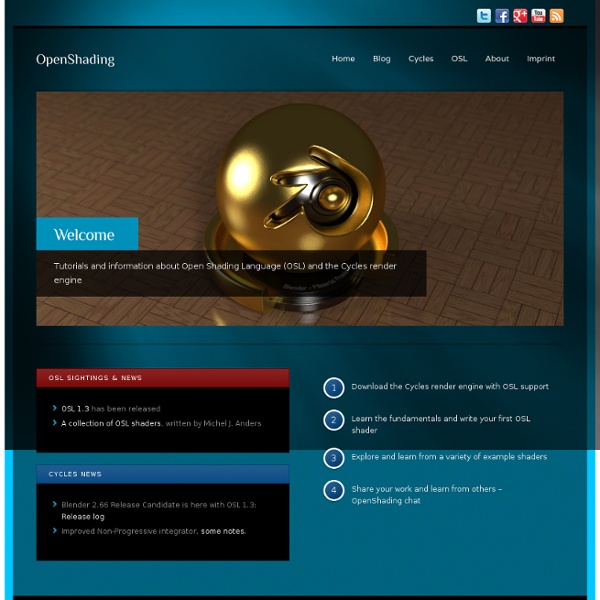



Small Blender Things Planet Blender News Home | YafaRay Intro to Node Groups The node system in Blender is very powerful gives unrivaled flexibility when it comes to creating shaders and compositing effects. One of the node systems most powerful features, though, is it’s ability to group nodes together. By grouping nodes we can effectively create custom, reusable nodes. This works by grouping sets of nodes together and then exposing specific settings, inputs, and outputs from the nodes within the group. By using node groups you can create complete libraries of shaders and compositing effects which can be linked or appended into any scene you’re working on.
Material World | Great 3D materials for blender 3D Primer – page 1 | SGFX 3D Primer page 1 | page 2 | page 3 | page 4 | page 5 1.01 Why write the 3D primer? I have wanted to write this article for several years and for several reasons. Firstly, when I started modeling finding answers to my questions was extremely difficult. I could always get an answer but it took time to find a tutorial that helped me or an artist that could explain the issue at the level I needed to hear it. Generally speaking artists/modelers are happy to help out someone new. You do need practice but it helps to understand how to achieve something by having it explained to you or even better seeing it done. I have used a lot of reference from Wikipedia as I find it invaluable as a source of information. Littered throughout these webpages are incidental information paragraphs like this one. 1.02 How to use the 3D Primer As a new modeler it can be very daunting to ask even a simple question. This Primer and any accompanying videos are laid out so that you can:
Setting Up A Render Farm What and Why? A render farm is simply a collection of networked computers that work together to render a sequence in less time. By dividing your sequence between multiple machines your total render time becomes a fraction of what it is on a single computer. Most production studios will fill huge rooms with server rack upon server rack, full of thousands of rendering computers (or render nodes as you’ll hear them called). But they’re also useful (as well as financially viable) for smaller teams or even individuals. A render farm can be a custom built cluster for a few thousand dollars or it can be a collection of arbitrary computers, a computer lab with networked stations, or you can invite all your friends over with their laptops. Blender makes it easy to take advantage of network rendering. I will be walking you through 3 stages. In the third stage I’ll show you how to take advantage of Blender’s included addon “Network Render”. Prefer to watch instead? 1. 2. 1. 2. 3. 4. 5. 6. 7. 8. 9.
3dzentrale Surface Knowledge | mínima expresión Procedural Stippled Finish August 5, 2013 in Surface Knowledge by Juan José Torres You might have noticed the stippled finish in the background wall I used for my last scene. Stippled finish paint was very popular back in the eighties, so I created this material to get an old fashioned feel that would fit the vintage hardware portrayed in the scene. Read the rest of this entry → Procedural orange skin October 25, 2012 in Surface Knowledge by Juan José Torres Just as I announced in my previous post, here is a new entry in the Surface Knowledge series available for download. Procedural wood May 8, 2012 in Surface Knowledge by Juan José Torres The next entry in this series is a much improved version of my procedural wood. Procedural rust May 7, 2012 in Surface Knowledge by Juan José Torres The first entry in this Surface Knowledge series will be the now fully procedural metal rust material. Surface Knowledge May 6, 2012 in Surface Knowledge by Juan José Torres
Development Fund Blender Foundation welcomes recurring donations to the Development Fund, which enables coders from the community to work for a set period of time on specific objectives. Projects or people selected for support are defined by the Blender Foundation’s project administrators. Selected projects are announced on this page, at the main developer mailing list, and on the code blog. At right we publish information about the monthly income we can spend. As alternative to recurring payments via PayPal, Gold Sponsors (or better) can donate annually via bank wire or PayPal. In this case we provide donors with an official confirmation of receipt for their records. September 2011 Grant for Jeroen Bakker, to complete his 10k funding target for the OpenCL compositor project.Grant for Lukas Toenne, to complete his funding target for Particle Nodes. October 2011 – March 2012 April 2012 – June 2012 July 2012 – Dec 2012 Grant for Sergey Sharybin – for 30h support/development per week, during 6 months.
Spectral Studio - Home - Spectral Studio Nature Academy: Box of Goodies I’ve realized that the only way to create realistic outdoor scenes is by adding lots and lots of nature elements. Things like trees, flowers, bushes, rocks etc. are essential in making the scene look “believable”. But I also know that creating these things by hand takes a very long time. And not everyone has time to sit down for hours on end and create tree after tree after tree. Which is why I’ve done the hard work for you :) The Box of Goodies! Inside this box of goodies you’ll find 9 nature models that you can keep. As well as this you’ll find a collection of grass reference photos that will help you to better create it in blender. Eg. What will you do with yours? Drop your email address in the box to the right and I’ll send the Box of Goodies your way.